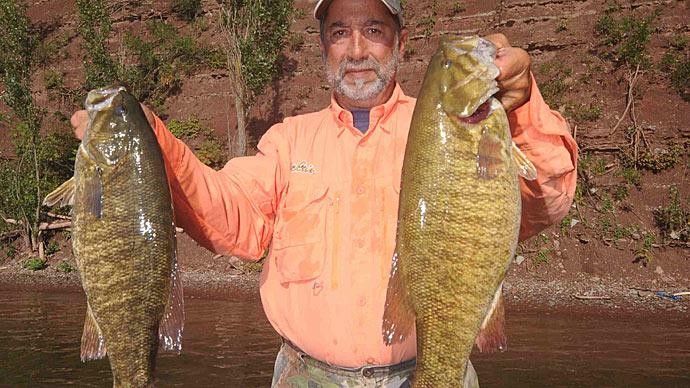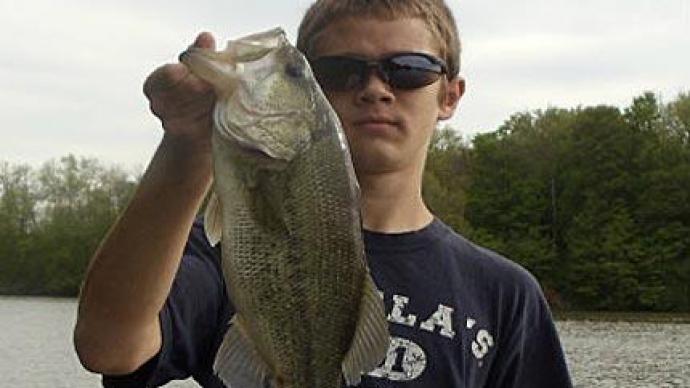| Brass & Glass |
Fourkiller, Mann, and Thliveros rarely use a brass weight and glass bead when fishing Carolina rigs, even though many anglers claim the noise generated by this combination attracts bass. There are times, however, when brass and glass is the way to go.
|

The Carolina rig has been around since the early days of tournament bass fishing, but it didn't always hold the high-priority status it enjoys today. Back then, most anglers targeted visible cover, while a small group preferred underwater structure and doted on the Carolina rig. These cliques took great pride in their methods and often viewed each other as inferior fishermen.
My how things have changed. In today's world of competitive bass fishing, versatility is essential. While it's OK to favor a particular technique, you'd better be well-versed in all forms of bass fishing if you hope to hold your own.
This applies to Oklahoma angler Marty Fourkiller, who has qualified for numerous Regionals and All-Americans and two FLW Tour Championships.
"I prefer flippin' and spinnerbait fishing," Fourkiller says. "But if I can't find bass shallow, I won't hesitate to switch to a Carolina rig."
The basic Carolina rig, which consists of a heavy weight, followed by a swivel leader and a Texas-rigged soft plastic bait, casts far, sinks fast, makes reliable bottom contact, and combs water quickly. These are considerable advantages when fishing expansive, sub-surface bass hangouts.
"If you're not familiar with a lake," Fourkiller says, "fishing a 3/4- or 1-ounce weight on a Carolina rig helps you feel what's on the bottom. It lets you know when you've found a stump, a cluster of weeds, a shell bed, or a rocky hump. It's easy to miss these spots throwing crankbaits.
A Carolina rig saved the day for Fourkiller during a major tournament on Sam Rayburn in February. The bass were in a pre-spawn mode and staging on submerged hydrilla beds about 13 feet deep. Carolina-rigged Zoom Brush Hogs and Baby Brush Hogs plucked enough largemouth bass from inside weed lines to give Fourkiller a fourth-place finish.
"In that tournament, the bass were holding along the inside edges of the weeds facing the bank," Fourkiller says, "They'll also relate to outside weed edges that drop into deeper water."
Fourkiller relies on his depth finder to follow inside and outside weed lines, casting a Carolina rig ahead of the boat and quartering into the vegetation. He then retrieves the rig back through the edge of the weed line. Key bass locations include points, turns, and cuts in the weeds, and any place a stump or some other piece of cover on the weed edge provides bass with something to move up against.
Fourkiller's basic Carolina rigging tackle consists of a 7-foot, heavy-action baitcasting rod, 15- to 20-pound line, and a 2 1/2-foot leader of the same weight tied to a 4/0 Gamakatsu hook. (Many anglers opt for 5- to 7-foot leaders when fishing Carolina rigs in submergent weeds.) Fourkiller goes with a 4-inch French Fry when looking for numbers of bass but ups the ante as high as an 8-inch lizard when he needs to cull small fish.
"If I'm fishing deeper than 10 feet," Fourkiller says, "I'll throw a 3/4-ounce sinker. If it's less than 10 feet, I'll throw a 1/2-ounce. I go to a 1-ounce weight after the spawn when I fish main lake ledges and that sort of thing."
During the summer, Georgia structure fishing ace Tom Mann Jr. often slings a Carolina rig over long bars and points leading to major creek and river channels. He especially likes long, gradual, sloping structures embellished with stumps and boulders in 5- to 12-feet of water.
"I target the ends of long points where they drop off," Mann says. "I also like humps out in the middle of the lake that are brushed by the current."
Mann employs a 3/4- or 1-ounce Carolina rig sinker. He goes with the 3/4-ounce size 90 percent of the time. He switches to a 1-ounce sinker when fishing deeper than 15 feet.
"In the summertime," Mann says, "I get away from the lizard and big worms. I Carolina rig a lot of smaller baits. One of my favorites is a 6-inch sculpin imitator bait. “Sculpins are common in Western impoundments, but the sculpin bait works great everywhere. It has two flat fins that plane the bait and a small curly tail."

When bass grow tight-lipped, Mann often induces strikes by fixing a silicone jig skirt behind the eye of a 4/0 Gamakatsu offset worm hook. Then, he rigs the hook with a twin-tail grub or a small crayfish.
"It looks just like a jig," Mann says, "except it's light. Once at Guntersville, I would catch three or four bass from a structure on some other lure, and they'd stop biting. Then I'd throw this 'jig' in there and immediately start catching bigger fish."
As with all fishing methods, Mann recommends experimenting with retrieves. He firmly believes most anglers fish the Carolina rig too slowly. Generally, he starts fishing as fast as the sinker will allow consistent bottom contact.
"Many times," Mann says, "I have my best luck just steadily winding it back."
Mann fishes a Carolina rig with a 7-foot medium-heavy baitcasting rod matched with a Shimano Stradic spinning reel. If he's fishing a bottom not composed of rock, he spools up with Seaguar Smackdown. When fishing rocky bottoms that fray braided line, he opts for 17- to 20-pound test Seaguar InvizX. He always drops one line size for the leader, say, 14-pound leader with 17-pound line. In most situations, his leader is 3 feet long.
The Carolina rig also comes through for Floridian Pete Thliveros in river systems and shallow Florida lakes. When fishing the famed St. Johns River, Thliveros relies on a Carolina rig with a 1-ounce weight to stay on the bottom when working structures influenced by the current.

"In rivers," Thliveros says, "I fish a Carolina rig on a 7-foot medium-heavy spinning rod and 15-pound Seaguar Smackdown. The leader is usually 14-test, but sometimes I'll drop down to 12- or 10-pound test."
The 14-pound main line, which is lighter than Thliveros uses in lakes, reduces line bagging caused by the current and prevents the sinker from being pulled off the bottom. The spinning rod is more forgiving than a baitcasting rod and less likely to break the line during the hook set.
"There are mainly three types of places I fish a Carolina rig in river systems," Thliveros says. "One is any place an eddy flows in the opposite direction of the main current. I usually find eddies in river bends, the mouths of pockets, or near islands."
To retrieve a Carolina rig in the direction of the eddy, Thliveros positions the boat into the main current just outside the eddy. Then, he casts downstream and brings the bait back with the flow of the eddy.
Sand bars also lend themselves to Carolina rigs. These structures can be large and generally run parallel to the river's main current. They may be from 10- to 20 feet on top and have deeper water on all sides.
"I use a Carolina rig to locate shell beds on sand bars," Thliveros says. "They're usually on the up-current point. In a tidal river, where the current moves back and forth, a sand bar has two up-current points that you can fish on different tides."
In most instances, Thliveros holds his boat into the flow in deeper water just off the sand bar. Then, he casts a Carolina rig onto the structure and retrieves the bait down current across the point of the bar.
Another river situation where Thliveros reaches for a Carolina rig is when fishing a deep or undercut bank swept by a strong current. The heavy flow blows lighter baits downstream so fast they never get down to the bass. A 1-ounce weight on a Carolina rig gets the bait down and holds it in the strike zone long enough to elicit a response.
Small baits, such as 4 to 4 1/2-inch finesse worms, produce the best for Thliveros in river systems. He rigs them with a 1/0 hook. Thliveros Carolina rigs bigger offerings, including 6-inch lizards and floating worms when fishing shallow Florida lakes, such as Okeechobee.
"On a shallow lake like Okeechobee," says Thliveros, "I drop down to a 1/2- or 3/8-ounce sinker. I fish flats with scattered eelgrass or some other type of sparse vegetation. There are also a lot of shell on the bottom of the lake, even rock in some places. Wherever I find those areas in open water, especially on the outside edges of pepper grass or hydrilla beds, a Carolina rig is a good bet." Because there is limited current to contend with in Okeechobee and other Florida lakes, Thliveros itches to baitcasting tackle and 17-pound test line. It comes in handy when a big bass buries in the grass.
Content provided by Bass Fishing Magazine, the official publication of FLW Outdoors




